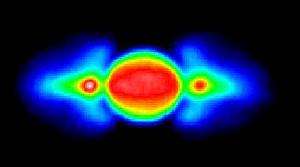Blog
Radio Jupiter
10 September 2014
 ATNF
ATNFIn the visible spectrum, Jupiter is a bright, star-like point in the night sky. Viewing it with the naked eye, it would be easy to confuse it with a star except for the fact that it doesn’t twinkle. At radio frequencies Jupiter appears very different. It doesn’t have a simple round shape, for example, and it is extraordinarily bright. So bright that it can outshine the Sun at some radio frequencies.
Much of this radio power is driven by Jupiter’s moon, Io. Tidal forces on Io due to Jupiter’s gravitational field cause the moon to be extraordinarily active geologically. Volcanic activity on Io throws material away from the moon, which tends to spread around Jupiter in a region known as the Io torus. This forms a plasma ring around the planet, through which Io orbits. As Io moves through the plasma torus, it generates a strong electric current between Io and Jupiter. This current is twisted by the rotation of Jupiter, causing a spike in radio intensity about every 10 hours. The radio brightness of Jupiter isn’t a perfect cycle, though, and can vary due to other factors such as solar activity.
Because of the brightness of Jupiter and the ease with which you can create a radio detector, listening to Jupiter is a popular project for student astronomers. For about $100 US, you can build a basic radio telescope to observe radio frequencies between 18 and 28 megahertz, which is pretty optimal for Jupiter. NASA has a project known as Radio Jove, where you can learn about how to build such a telescope, and RadioSky has more details about observing Jupiter, including recorded sounds of the planet.
Usually when we think of amateur astronomy, we think of lens and mirror telescopes for looking at visible objects, but it can also be more akin to ham radio. Just as a first view of Jupiter’s moons can inspire a child’s interest in astronomy, so too can listening in to Radio Jupiter.